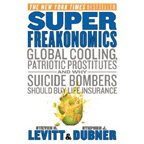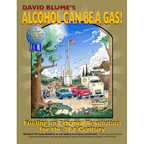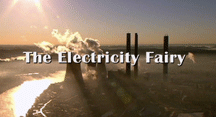We Had Some Crazy Times Together…
Review by Jed Grubbs
Superfreakonomics is like that outrageous friend of yours from college. Initially, all the scandalous things he says and does are highly entertaining and engrossing. Time goes on, though, and you begin to wonder what this guy won’t do for attention. You start to feel it’d be nice to wake up without a hangover and a black-eye (at least on weekdays).
As you begin spending less time with him and taking what he has to say with a grain or two of salt, don’t feel too guilty. You’re simply concerned about your future – his too. It’s only natural.
Steven Levit and Stephen Dubner’s bestselling Superfreakonimics (William Morrow, $29.99) is much the same. Initially, it’s pretty enthralling. The authors examine a variety of “freaky” topics from an economist’s perspective. Topics include the declining price of oral sex, altruism, drunk walking and monkeys with cash. Good times.
Throughout, the authors maintain: “The economic approach isn’t meant to describe the world as any one of us might want it to be, or fear that it is, or pray that it becomes- but rather to explain what it really is.” The two proclaim, “Most of us want to fix or change the world in some fashion. But to change the world, first you have to understand it.”
On board? Me too. Chooo! Chooo!
Suddenly, though, you find Levit and Dubner pushing a cheap, simple, altogether reckless fix for global warming and the alarm bells begin to sound; think of it as that time in college when you suddenly find yourself naked running from the police with that insane friend. Maybe, it occurs to you, I shouldn’t be drinking everything this guy has to offer.
Essentially, Levit and Dubner confidently suggest that global warming and increased carbon dioxide in the atmosphere can easily be fixed by sending millions of gallons of sulfur dioxide into the stratosphere every year.
Suddenly, I’m having less fun and want my clothes back.
The authors’ cheap and easy global warming fix has been widely debunked by the scientific community. Economists and climate science experts alike have highlighted misleading statements and discredited arguments within. Elizabeth Kolbert of The New Yorker, who has covered climate change extensively, noted that “just about everything [Levitt and Dubner] have to say on the topic is, factually speaking, wrong.”
I’m concerned about my future, Superfreakonomics. I’m concerned about yours too. Let’s not pump that SO2 into the atmosphere.
Distilling Your Way to a Better Energy Future
Review by Jeff Deal
Ever wonder how we came to pay the super-affluent Petro-chemical industry to burn their toxic waste product as a transportation fuel? Or why Henry Ford’s Model T was originally a flex-fuel vehicle? Maybe you’ve scratched your head as to why we unhealthily feed beef cattle the kernel of the corn instead of the cellulosic corn silage their multi-stomach gastrointestinal systems so aptly crave – and in the process lose fatter cows, a high protein animal feed, an “eco-friendlier” transportation and cooking fuel and a host of tasty spirituous liqueurs to boot.
Thanks to farmer-permaculturalist David Blume’s tome Acohol Can be a Gas, you needn’t ponder these questions further! From David’s 30+ years of experience with biofuels, permaculture and farming has emerged the 10 part PBS Series, Alcohol as Fuel, and now his greatly anticipated 600 page magnum opus – three volumes bound in a single book detailing the history of alcohol, the making of alcohol, and the many uses and benefits of alcohol. The foreward of the book is even written by pioneering engineer and ecological thinker Buckminster Fuller, who was awarded the Presidential Medal of Freedom in 1981 by then President Ronald Reagan.
So if you’re still wondering how we can safely capture the nutrients from waste water treatment plants and agricultural fertilizer now causing the algae bloom in the Gulf of Mexico, while gaining a fuel fit for Indy race cars and astronaut piloted high performance jet aircraft, surf to Permaculture.com and get your copy straight from the author – including the riveting two hour DVD special of the same name, Alcohol Can Be a Gas. Enjoy your biofueled, knowledge-filled odyssey!
Movie Review: The “Magic” Behind the Light Switch
By Derek Speranza
There is often a mental disconnect between flicking on the light switch and actually thinking about the source of that electric power. Tom Hansell’s The Electricity Fairy reminds us that there is no magical fairy leaving electricity under our pillow.
The film begins with a cinematic overview of the history of Appalachian Coal mining and electricity and is very accessible, even for people who know nothing of the subject. It examines the lives of real Appalachians who were raised on coal mining and demonstrates the enormous impact of the industry on the region.
From every day citizens to government officials, from environmental activists to Dominion Power executives, the film examines every aspect of the debate surrounding the cleanliness of coal. Eventually, the controversy is embodied in the battle over the approval of Dominion’s new coal-fired power plant in Wise County, Va.
In the spirit of true documentary filmmaking, The Electricity Fairy shows rather than tells. Hansell does not skew the focus of the story with a predisposition or provincial agenda, which is too often the case with modern documentaries intent only on incensing the viewership (á la Michael Moore), but instead gives equal time to both sides of the argument. The Dominion Power executives – who are not portrayed as evil corporate villains – share their honest beliefs about the economic benefits of the power plant, while the renewable energy camp points out the negatives, such as dangerous mercury levels in the water, air pollution and the devastation caused by mountaintop removal mining.
It is this lack of sensationalism and commitment to honesty that allows The Electricity Fairy to believably deliver the facts, and in doing so it is guaranteed to leave the viewer thinking a little more about what actually happens with the flick of a light switch. In the sweeping landscapes of the film (courtesy of some impressive cinematography), the audience can see first-hand the stark destruction caused by strip mining, and is also reminded of a region uncertain of where to go from here.
Related Articles
Latest News

Leave a comment
Your email address will not be published. Required fields are marked *







